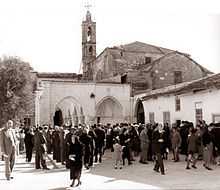Notre Dame de Tyre
| Notre Dame de Tyre | |
|---|---|
| Benedictine Abbey of Our Lady of Tyre | |
|
Notre Dame de Tyre in 2014 | |
| Location | Arab Ahmet, Nicosia |
| Country |
de jure Cyprus de facto Northern Cyprus |
| Denomination | Armenian Apostolic |
| History | |
| Founded | 13th century |
| Architecture | |
| Style | Gothic |
Notre Dame de Tyre (Turkish: Ermeni Kilisesi) is a 14th-century monastery in Nicosia, Cyprus. It is located in the Arab Ahmet quarter, in Salahi Şevket Street, formerly known as Victoria Street.[1]

The existing building is gothic in style and consists of a square nave, with a semi-octagonal apse, cross vaults an arch covering the western part, a bell tower (built in 1860) and convent buildings to the north of the church. To the east of the nunnery buildings is the sarcophagus of Lady Dampierre, an Abbess of the nunnery. On the church floor are tombstones dating from the 14th and 15th centuries.
The church was reportedly damaged following its placement in the Turkish Cypriot part of the city following the 1963 division and the 1974 Turkish invasion of Cyprus. Recently, it has been selected for preservation and restoration by the UNDP as it provides an opportunity to preserve a site of historical and cultural significance. It is expected that the renovation will be complete by 2011, according to the sign placed outside the complex's main entrance.
History
It is believed that the original church, known as the Benedictine Abbey of Our Lady of Tyre, was founded in the 13th century as a principal convent following the fall of Jerusalem. In 1308, the Lusignan king, Henry II of Jerusalem, repaired the church after it was destroyed by an earthquake. As many of the nuns were Armenian in origin, it came under the Armenian Church before 1504.[2]
In 1570, following the capture of Nicosia by the Ottomans, the keeping of the Paphos Gate, the church, and the surrounding area were handed over to the Armenians by Sultan Selim II.[3]
The Armenian Prelature of Cyprus was housed next to the church, until the 1963-1964 intercommunal violence, when it was placed in the Turkish Cypriot quarter of the city. In 1920 the descendants of Artin Melikian restored the church, and built the Melikian Elementary School on the grounds of the church. In 1938, the Ouzounian Elementary School was established by Dikran Ouzounian. There was also a kindergarten, originally built in 1902 and called Shoushanian.
Inside the complex was also the Armenian Genocide monument, built in 1932, the second oldest of its kind around the world. Opposite the church complex, to the west, were the Nicosia AGBU premises, while to the south the Armenian Club was located. Very near the complex were also the premises of AYMA.
Since 1963, the church has been located in North Nicosia, under Turkish Cypriot administration. There have been reports of damage to the church, but it was renovated in 2010-2011.
See also
References
- ↑ Keshishian, Kevork K. (1978). Nicosia: Capital of Cyprus Then and Now. The Mouflon Book and Art Centre. p. 150.
- ↑ Hadjilyra, Alexander-Michael (May 2009). "Booklet on the Armenians of Cyprus". Kalaydjian Foundation. Retrieved 16 May 2010.
- ↑ Hadjilyra, Alexander-Michael (May 2009). "Book The Armenians of Cyprus" (PDF). Kalaydjian Foundation. Retrieved 16 May 2010.
External links
| ||||||||||||||||||||||||||||||||||